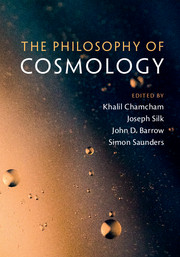Book contents
- Frontmatter
- Contents
- List of Contributors
- Preface
- Acknowledgments
- Part I Issues in the Philosophy of Cosmology
- 1 The Domain of Cosmology and the Testing of Cosmological Theories
- 2 Black Holes, Cosmology and the Passage of Time: Three Problems at the Limits of Science
- 3 Moving Boundaries? – Comments on the Relationship Between Philosophy and Cosmology
- 4 On the Question Why There Exists Something Rather Than Nothing
- Part II Structures in the Universe and the Structure of Modern Cosmology
- Part III Foundations of Cosmology: Gravity and the Quantum
- Part IV Quantum Foundations and Quantum Gravity
- Part V Methodological and Philosophical Issues
- Index
- References
1 - The Domain of Cosmology and the Testing of Cosmological Theories
from Part I - Issues in the Philosophy of Cosmology
Published online by Cambridge University Press: 18 April 2017
- Frontmatter
- Contents
- List of Contributors
- Preface
- Acknowledgments
- Part I Issues in the Philosophy of Cosmology
- 1 The Domain of Cosmology and the Testing of Cosmological Theories
- 2 Black Holes, Cosmology and the Passage of Time: Three Problems at the Limits of Science
- 3 Moving Boundaries? – Comments on the Relationship Between Philosophy and Cosmology
- 4 On the Question Why There Exists Something Rather Than Nothing
- Part II Structures in the Universe and the Structure of Modern Cosmology
- Part III Foundations of Cosmology: Gravity and the Quantum
- Part IV Quantum Foundations and Quantum Gravity
- Part V Methodological and Philosophical Issues
- Index
- References
Summary
This chapter is about foundational themes underlying the scientific study of cosmology:
• What issues will a theory of cosmology deal with?
• What kinds of causation will be taken into account as we consider the relation between chance and necessity in cosmology?
• What kinds of data and arguments will we use to test theories, when they stretch beyond the bounds of observational probing?
• Should we weaken the need for testing and move to a post-empirical phase, as some have suggested?
These are philosophical issues at the foundation of the cosmological enterprise. The answer may be obvious or taken for granted by scientists in many cases, and so seem hardly worth mentioning; but that has demonstrably led to some questionable statements about what is reliably known about cosmology, particularly in popular books and public statements. The premise of this chapter is that it is better to carefully think these issues through and make them explicit, rather than having unexamined assumed views about them shaping cosmological theories and their public presentation. Thus, as in other subjects, being philosophical about what is being undertaken will help clarify practice in the area.
The basic enterprise of cosmology is to use tested physical theories to understand major aspects of the universe in which we live, as observed by telescopes of all kinds. The foundational issue arising is the uniqueness of the universe [66, 27, 28]. Standard methods of scientific theory testing rely on comparing similar objects to determine regularities, so they cannot easily be applied in the cosmological context, where there is no other similar object to use in any comparison. We have to extrapolate from aspects of the universe to hypotheses about the seen and unseen universe as a whole. Furthermore, physical explanations of developments in the very early universe depend on extrapolating physical theories beyond the bounds where they can be tested in a laboratory or particle collider. Hence philosophical issues of necessity arise as we push the theory beyond its testable limits. Making them explicit clarifies what is being done and illuminates issues that need careful attention.
- Type
- Chapter
- Information
- The Philosophy of Cosmology , pp. 3 - 39Publisher: Cambridge University PressPrint publication year: 2017
References
- 2
- Cited by

